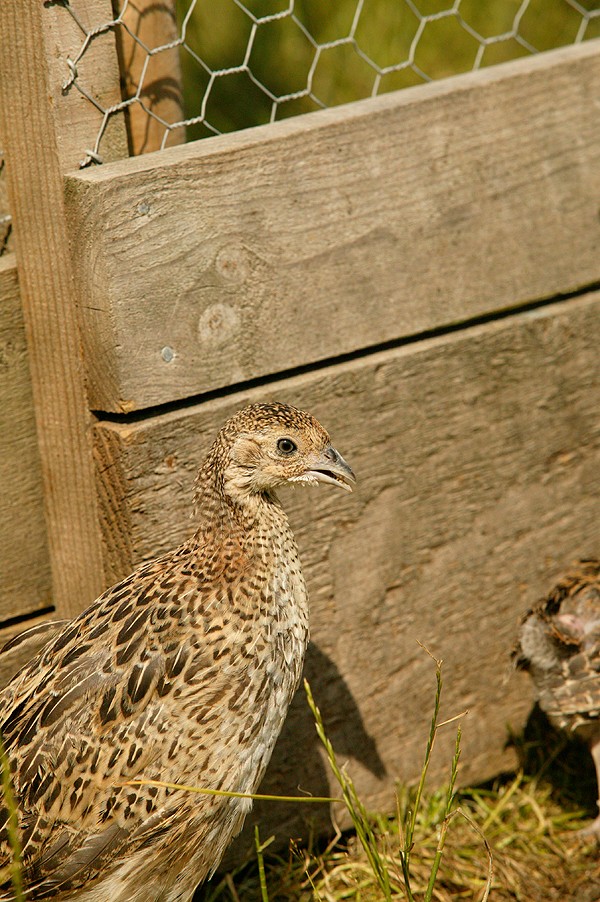A perfect poult release

If you want to manage a smooth and stress-free pheasant release, you really do need to understand a bit about what goes into rearing pheasants. This is why the GWCT?s Pheasant Release Day always starts at a game farm, in this case Holme Park Game Hatcheries in Berkshire.
Held a fortnight ago, the day began with presentations by GWCT?s head of wildlife disease and epidemiology, Chris Davis, and myself. These talks covered choice of release site, pen construction, habitat management and release density, plus a detailed insight into what to do to maintain good health during the release process.
One of Chris?s key themes on the day was to stress the importance of continuity in managing birds. For a shoot buying in poults it is all too easy to consider their delivery as the start of the process. In practice, what arrives is a batch of rapidly growing young birds, which need to adapt quickly and easily to the release pen environment. This means that they need the smoothest possible transfer at what is a stressful time for them.
Diet changes can easily upset birds, so making sure you have ordered some of the same food from the same supplier that the game farm uses is a good idea. This will require an anticoccidial drug to help the poults fight off diseases, so you will need to find a vet to obtain the right prescription well before your birds are due.
Another aspect of this continuity theme, raised by local keeper Mike Pratt, was whether or not to wing-clip poults. As Mike said, this used to be the way, with clipped poults unable to leave the pen and fall into the clutches of predators.
This is fine, but in practice it forces birds that should be strong flyers into living on the ground, and must increase stress.
Experience dictates that newly released birds that might have chosen to roost in the bushes are forced to jug on the ground. This means that most keepers have experienced a mass kill in the pen at some stage. Mike pointed out that with full-winged poults a few adventurous ones may fly out early, but are quite likely to fly back in too. They are also more likely to be able to dodge predators. Mike summarised the mood by saying, ?It took a leap of faith to stop clipping, but once I had, I wished I had made the change earlier.?
The next phase of the day was a fascinating rearing-field tour led by Holme Park manager Tim Robbins. Here we saw good old-fashioned, grass-based rearing, with serried ranks of identical huts and runs each providing for the needs of a batch of 200 chicks. ?This may take more labour, and therefore cost more than highly intensive systems,? said Tim, ?but it is the only way that we are comfortable with, in terms of producing a good end product. Also, we are surrounded by suburbia, and the public seem to be happy that we look after our birds well.?
Many of the delegates were surprised to see the way in which pheasants had grazed their runs. This was most apparent with the breeding stock, but applied in rearing units, too. This may not be seen as an essential food source, but it is clearly something that the birds like, and it is only available where birds are kept on grass.
Preparations for release
Holme Park rotates its use of grass, and regularly re-seeds to ensure a clean start for the birds. This year the rearing field is full of wildflowers providing an ideal habitat for pheasants, with insects and flora for them to eat. This is great for the birds, offering a more natural diet along with their rations.
In the afternoon we went to nearby Englefield Estate, where headkeeper David Wiggins had begun his release pen preparations, with the extensive ride network mown to allow plenty of sunny areas for the poults when they arrive. When doing this, especially in a big pen, it is important that you mow a track to all the remote corners. This way you provide an easy route back to the centre for the more adventurous poults.
Now is also the time to inspect the pen for holes. Any big breaks will probably have been repaired, but the little ones that let in ground predators are harder to spot. A dual job of mowing up to the fence inside and out, plus an inspection, works well. It also means that the last-minute check, when the birds are due, is unlikely to bring any serious surprises.
Good pen management
When David?s pen was first built 20 years ago, it was part of the deer park and had a bare grassy floor. A good number of shrubs were planted, and these are still in evidence. But much natural shrub growth is now present, showing that old bare woodland sites often have the potential to develop good cover if enough light is let in by thinning the canopy. As David pointed out, ?We need to keep working to maintain what you see, and we will be felling a few more of the bigger trees this winter to maintain the sunny areas.? Personally, I wish more people understood that sentiment.
For more about Holme Park Game Hatcheries, visit www.holmeparkgamehatcheries.co.uk








